A simple survey of how time has been analysed, measured, argued about,
defined and understood. England had a key part to play in navigation and the present world time. Absolute dates
are referred to as CE, Common Era, or BCE, Before Common Era which are equivalent to the AD and BC of the
English Christian church calendar. Time is now referred to as UT, Universal Time, although based on Greenwich Mean Time.
In the beginning ...?
Early cultures worshipped the sun and the moon and measured the day
and the seasons by the sun and the tides by the moon. They saw time as a series of cycles.
It was difficult to record the Year, which is the length of time it takes for the earth to go
round the sun (and in early times it was obvious that the sun moved around the earth anyway).
The easiest way to measure time by the Day, sunrise to sunrise.
Unfortunately the day varies in length, longer in summer than in winter. This didn’t matter to primitive man.
As he developed a curiosity about the world around him, at some point he noticed that the moon appears and disappears
in roughly a 30-night cycle. So early astronomers observed the moon cycle and gave it a name which in due course in
the English language became the ‘moonth’ and in time the Month. This was useful to time when
festivals should occur. This period was also useful to sailors for predicting peak levels for high and low tides.
As time passed it was agreed that actually an average month was nearer 29½ days so months were made
alternating 29 and 30 so the lunar year totalled 354 days.

The moon’s phases from New Moon to Full Moon and back to New again.
There are actually three definitions of a month. The time it takes to return
to the same longitude after circling the earth is the ‘tropical’ month which is about 27.3216 days.
The time it takes for the moon to move around the sky and return to its exact place in the sky against the background
stars is called an astronomical or ‘sidereal’ month which is about 27.3217 days. However as the earth
is travelling in orbit round the sun, it takes longer for the moon to return to exactly the same phase (which depends
on its angle to the sun) as it was at the start of the month. The time it takes to achieve this is around 29.531 days.
Observing the phase is the easiest option and this period of time is called the lunar or ‘synodic’ month.
The diagram below may make things clear.

The different months.
Two units are not linked directly to the heavens. The seven-day
Week may have been conceived by the Babylonians who noted that the sun, moon and five known
planets make up the number seven. The Jewish people were in captivity in Babylon in the 6th century BCE
and the concept was given a boost when the Jewish bible was written and seven was used for the number
of days for the creation of the world. The seventh day in the three ‘religions of the book’
is a day of rest and contemplation and this has been adopted around the world as a practical system to
organise work. The Century was invented somewhere between the 15th and 18th centuries. It is
useful for putting events in their historical context but is unhelpful as it is purely arbitrary.
Some important events, such as monarch’s reigns or voyages of discovery, inconveniently overlap
the centuries.
There is another minor division of time which goes back to when time was
measured by the number of nights passed instead of the number of days. This has left English with a ghost
from the past, the Fortnight or fourteen nights equal to two weeks or roughly half a month.
The first peoples to look at time in detail were the Sumerians, living
in present day southern Iraq, around 2000 BCE. Their numbering system based on 6 and 60 has left echoes with
us even today in the 360 degrees in a circle and 60 minutes in an hour. They also developed astrology or the
prediction of events on earth by the position of bodies in the heavens. The number 12 was the number of
star constellations along the ecliptic, the sun’s apparent journey through the heavens, and this may
have influenced the decision to choose to divide both day and night into 12 hours.
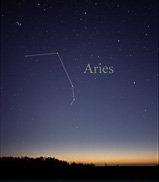
In Babylonian times, the star constellations along the ecliptic starting at the spring equinox in March were
Aries, Taurus, Gemini, Cancer, Leo, Virgo, Libra, Scorpio, Sagittarius, Capricorn, Aquarius and Pisces.
Due to the precession of the equinoxes, the time of year the sun is in a given constellation has changed
and the point of the equinox has moved from Aries into Pisces. The sunrise in each constellation was
regularised to be within a 30-degree arc although the constellations do differ in size. Incidentally the word
‘Zōdiac’ comes from a Greek word Ζωιδιάκος linked to ‘Zōdion’ ζῴδιον
meaning ‘little animals’. The sun’s constellation at your date of birth was said to influence
human life and the myth of astrology is still alive at the present day.
Two different approaches developed. A solar calendar with a 365-day year
being the length of time between two vernal equinoxes which occur when the centre of the sun appears to cross
the equator from south to north. And a lunar calendar with a 354-day year being twelve lunar months, each month
being the number of days from one full moon to the next. The Babylonians, following on from the Sumerians,
favoured a lunar calendar with twelve alternating 29-day and 30-day lunar months plus a few extra days each year
to keep in line with the seasons.
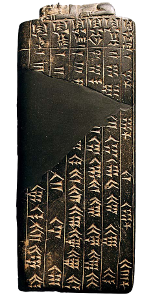
A Babylonian Almanac from around 1000 BCE written in cuneiform script.
It lists the twelve months in order followed by the days which are favourable to
success in enterprises.
Courtesy of The Schøyen Collection (London & Oslo)
The Egyptians decided that a solar calendar made more sense particularly
since the sun-god, Ra, was their chief deity. They calculated a year to be 365 days so they chose 12 months of
30 days and 5 days added to the year by the god Thoth. The Nile seasons of flooding, growth and harvest were
thus in harmony with the calendar.
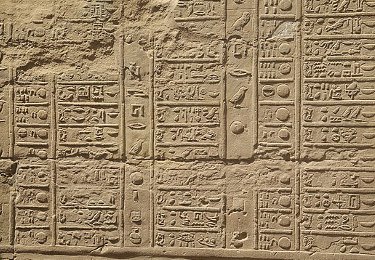
On the walls of the Egyptian temple at Kom Ombo,
this detailed calendar is carved in stone.
Around 140 BCE the Greek astronomer, Hipparkhos wrote a text called ‘On
the Length of the Year’. He had taken the length of the solar tropical year accepted at the time as 365¼
days and by observations worked out that it was causing a difference of one day in about 300 years. So he calculated
the length of the tropical year to be 365¼ minus 1/300 days that is 365.246667 days or 365 days 5 hours 55 mins,
which differs from the present-day mean value of 365.242190 days or 365 days 5 hours 48 mins 45 secs by only about six minutes.
An amazing result which future generations, notably Sosigenes (see below), failed to make use of.
In ancient Rome, a priest observed the sky and announced a new moon cycle
to the king. For centuries afterward, Romans referred to the first day of each new month as Kalends
(from their word ‘calare’, which means ‘to proclaim’). The word calendar derived from
this custom. The two other fixed points in each month were the Ides and the Nones. Instead of
simply numbering the days, they referred to a day in relation to the nearest Kalend, Ide or None.
A common way for measuring short lengths of time was the nundinum,
an eight-day period, since town markets were held every ninth day. A fasti was a list of days, originally
those favourable to the Gods, but latterly just a calendar showing major festivities and celebrations. The days
of the nundinum were indicated with letters of the Latin alphabet, from A to H.
The earliest Roman calendar had a year of ten months with alternately 31
and 30 days so in all it was 305 days long. This of course rapidly got out of sync. with the seasons and two
more months were added but the days per month went awry and ended up with a year of 354 days. This still drifted
against the seasons by about 11 days each year as the sun’s year of 365 days outran the moon’s year
of 354 days. Trying to follow the moon phases exactly has the added difficulty that a month can vary between 29
days 6 hours and 29 days 20 hours so an average month of 29½ days is around 44 minutes short. Spring Festivals
at the vernal equinox on 25th March began to move back into winter and drastic action was needed.
It was a Greek astronomer Meton living in the 5th century BCE who observed that,
every 19 solar years, the particular phase of the moon and its position in the night sky are the same on the same date.
He worked out that if you took 12 years of 12 months plus 7 years of 13 months this is almost exactly equal to 19
solar years. In Meton’s time, 19 solar years measured by the stars = 6939.604386 days and 235 lunar (synodic)
months = 6939.687084. We are still nearly 2 hours adrift over 19 years but that’s not a bad result considering
there is no actual reason to suppose that the timing of the orbits of sun and moon are directly linked. For his
calendar he began by lining it up with the solar year. He added an extra month of 30 days to seven years (namely years
3, 6, 8, 11, 14 17 and 19) and added 1 extra leap day in normal years 1, 4, 10 and 15.
Now he made each month 30 days and the cycle 7,050 days and then removed a day every 64 days working through the cycle
including the intercalary months giving a total of 110 29-day months and 125 30-day months. This worked out
roughly alternately 30 and 29-day months.
 Right click to view full-size or
Right click to view full-size or
![]()
Courtesy of www.calendarbede.com
Meton’s calendar had an average year length of 365.26315 days which,
compared with actual year length at his time of 365.24233 days, is only 30 minutes too long. This
elegant reform was accepted by the Babylonian civilisation and influenced most of the world’s lunar calendars
to become lunisolar with the notable exception of Islam.
The year number in the Meton cycle was called the Golden Number. It can be calculated for any year by adding 1
to the given year, dividing by 19 and noting the remainder. If there is no remainder the Golden Number is 0.
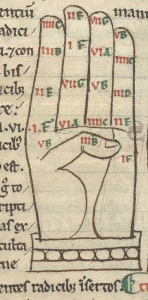 As an aside this 11thC. manuscript
As an aside this 11thC. manuscript
shows a diagram for counting up to
19 using finger joints and tips.
Note: The ratio 235:19 is embodied in the gear train of the Antikýthera mechanism, a mechanical astronomical
computer, possibly built in Rhodes before 80 BCE and recovered in 1900 CE from an ancient shipwreck off the Greek island
of Antikýthera.
The Roman Emperor, Julius Caesar, assisted by Alexandrian mathematician
Sosigenes, created a new Roman solar calendar of 365¼ days which ended the previous chaos in the Roman world.
Each year had 365 days with an extra day added every 4 years; this reduced the average error to around 11 minutes
over per year which the Empire could live with. The calendar came into use on 1st January 45 BCE. From now on an
educated person living in the Roman Empire would know the exact date of his birth and exactly how old he was. Sadly
in England the average uneducated person knew neither of these things until the Church began to record births in
the 16th century.
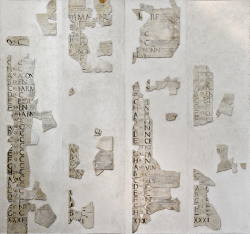

The Fasti Praenestini. A marble calendar set up by Verrius Flaccus, around
9 to 6 BCE in the village of Palestrina (Praeneste to the Romans).
There are fragments from the months of January, March, April and December.
Courtesy of Palazzo Massimo alle Terme, Rome, photographed by Marie-Lan Nguyen.
Emperor Constantine had a Christian British-born wife, Helena, who influenced
her husband‘s religious views and this may have prompted him to make some calendar amendments. In 321 CE he
abolished the kalends, nones and ides system and set out a seven-day week with the seventh day as a day of rest
and worship. He named it ‘Dies Solis’ ‘The day of the sun’ partly perhaps to satisfy the
widespread Roman cult of Mithras and other pagan sun-worshippers. Christians justified the name by designating
Christ as ‘the light of the world’. The Romans brought their system of time and date with them to Britain.
One basic problem for Roman, Greek and Egyptian mathematicians was that, although
they had fractions, decimals had not been invented. Another consideration for the religious world view, widely held in
the English ‘Middle Ages’, was that, if an exact number for the length of a year did exist, it was a sacred
number known only to God and hence would be unknowable by Man.
Calendars around the world
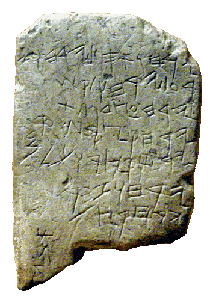
The Gezer Almanac dating from the 10th century BCE was found at the
Gezer archaeological site west of Jerusalem and may be a scholar’s note.
It describes the agricultural cycle, giving the tasks to be performed,
for example, ‘a month of hoeing flax’ and ‘a month of barley harvest’.
It is now in the Museum of the Ancient Orient in Istanbul, Turkey.
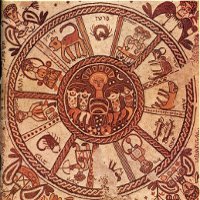
Mosaic pavement from a 6th century CE synagogue at Beit Alpha, Israel.
The Babylonian twelve astrological signs of the zodiac surround a central chariot of the sun (showing Greek ,
influence) while the corners depict the four turning points of the year, the two solstices and two equinoxes.
The Hebrew calendar works to lunisolar system based on the Metonic cycle and was set up in 359 CE.
It has 6 different lengths of year, a common deficient year, 353 days, a common regular year, 354 days,
a common complete year, 355 days, a leap deficient year, 383 days, a leap regular year, 384 days, and a
leap complete year, 385 days. From the Christian churches point of view, the date of Christ’s
resurrection and hence their festival of Easter was set by the Hebrew calendar which applied in Judaea
at the time the event happened. The date of Creation, Anno Mundi 1, corresponds to sunset on 7th
October BCE 3760 in the Julian Calendar.
The Islamic calendar is purely lunar. It was set up at the time when the prophet Muhammad travelled
from Mecca to Medina, called the Hijra, with its starting point at sunset on a day equivalent to 16th
July in the year 622 CE. Each month begins when religious authorities announce the appearance of the crescent
moon two days after the new moon. Being based on moon cycles, a given date drifts back through the seasons.
For a desert nomad, this is less of a problem than for a farmer who likes his seasons to occur in the same
months each year and also the equinoxes and solstices which divided the year into useful quarters. 2000 CE
was 1420/21 Anno Hegirae.
The traditional Hindu calendar is lunisolar and the official Indian national calendar is a solar
calendar that was introduced in 1957. Years are counted in the Saka Era, which began year 0 in the year 78 CE.
The National Calendar is synchronized to the Gregorian calendar so the extra day of a leap year occurs
simultaneously in both calendars. It was Hindu numbers which reached western Europe around 976 CE that
slowly replaced Roman numerals, even 500 years later you might still have a year written as MCCC94.
The Bahá’í calendar, used by the Iranian Bahá’í faith, is a solar
calendar with regular years of 365 days, and leap years of 366 days. Years are composed of 19 months of 19 days
each, (361 days) plus an extra 4 days in a regular and 5 in a leap year. Years in the calendar begin at the
vernal equinox, and the calendar itself began at sunset on Wednesday 20th March 1844 (CE). At present, the
Bahá’í calendar is synchronized to the Gregorian calendar so the extra day of a leap year
occurs simultaneously in both calendars.
The Chinese Republic Calendar was instituted by Sun Yat-sen when he announced that the 13th day of
11th Month of the 4609th year of the Yellow Emperor's reign (corresponding to 1st January 1912 CE.) would
be the first year of the Republic of China. It runs in parallel with the Gregorian calendar. The traditional
Chinese Calendar is still used for astrology and public festivals. Because it is based on the regnal year of
each ruler there is no universally agreed upon ‘epoch’ or starting point for the Chinese calendar.
Tradition holds that the calendar was invented by Emperor Huang-di in the 61st year of his reign in what is
now known under the Gregorian calendar as 2637 BC.
The Easter Question
Any festivals decided by the moon’s position will not have a fixed date and
this is a problem in a number of religions. Since the Celts and Anglo-Saxons converted to Christianity independently there
had been a problem in deciding the date for Easter, the festival marking Christ’s rising from the dead. This was
originally agreed by everyone to be the first day of the Jewish Passover which began at sunset on 14th day of the Jewish
month of Nisan. This is the appearance of the first full moon following the vernal (spring) equinox. As time passed it
was decided that Easter should celebrate not the Passion of Christ but the Resurrection and be on the Sunday within the next seven days in line with the Jewish Feast of Unleavened Bread.
Originally letters were sent out by the Church leaders giving the date of Easter but
these sometimes failed to arrive so instead Easter tables were drawn up and sent out to the churches. By 300 CE the spring
equinox was being assumed to be on a fixed solar date, the 21st March (in fact the equinox can be on any one of five dates
from March 18th to March 22nd - in 2000 CE it was 20th March). However the Council of Nicæa in 325 CE decreed Easter should be on the first Sunday after the first full moon after the vernal equinox (confirmed as 21st March). Most definitely it must not be on the first day of the Jewish Passover and, if this happened, the following Sunday had to be substituted. This gave a range of dates for Easter from 15 Nisan and 21 Nisan (22nd March to 25th April). At Nicæa it was also agreed to continue to entrust the calculation of Easter tables to the leading astronomers at Alexandria.
The Alexandrian Easter Tables
The calculation of the table for date of Easter year by year, accepted by Roman Church,
was carried out by an Alexandrian bishop, Cyrillus, covering five 19-year periods from 437 to 531 CE. Dionysus Exiguus
(“Denis the Small”) a Greek monk from Scythia Minor living in Rome, extended these to cover from 532 to 627
CE. He used 21st March as the equinox date, and an Easter date ranging from 22nd March to 25th April. A cycle of Easter
dates repeats every 532 years. In Dionysus’ time dates were reckoned by the Roman calendar and years were reckoned
from the year Diocletian became Emperor of Rome. Dionysius fixed Christ’s birth so that it fell on 25 December
753 AUC (ab urbe condita, that is, since the founding of Rome), thus making the year 1 of the current era start on 1
January 754 AUC. (Dionysus named the first year, year 1 AD as the concept of zero was not known in his time). The first
year of Dionysus’ new calendar was called Anno Diocletiani 247 in Rome. However Dionysus somehow worked out
that this was exactly 531 years since the birth of Christ so he named the first year of his
Easter table Anno Domini nostri Jesu Christi 532 and thus set in
action the Christian AD year-numbering system that we use today. Note however that the lunar calculations were still
based on Meton’s figures which were incorrect by nearly two hours.
The Christian Calendar start date confusion
Anno Domini counts years from the traditional date of the incarnation
(”becoming flesh”) of Christ and, since its introduction by Dionysus, it was in use in much of Europe by
the Middle Ages. Dionysius worked on AD beginning at the ‘birth’ of Christ, but by the late 9th century
Christ’s conception was being considered as his incarnation, so the year would begin not at the Nativity,
December 25th but at the Annunciation when the Angel visited Mary, March 25th.
In passing, as AD/CE began with year 1, this means that 2000 years after the incarnation were only completed by 1st
January 2001 so our second millenium celebrations were a year early.
Also in passing, the actual year of the birth of Christ is unclear. King Herod
the Great died just before Passover in 4 BC but, in the Christian gospels, Luke (1:5) says Christ was conceived during
the his reign and Matthew (2:1) says Herod was alive when Christ was born and (2:16) that Herod ordered the
‘Massacre of the Innocents’ in response to Christ’s birth. Luke (2:1-3) also says that Christ was
born when Cyrenius was governor of Syria and carried out the census of the Roman provinces of Syria and Judaea. The
Jewish historian Josephus in “Antiquities of the Jews” indicates that ‘Quirinius’
governorship of Syria began in AD 6, and that the census occurred sometime between AD 6 and 7.
To make it more universal Dionysus’ numbering is also called
‘Common Era’ (CE for short) and BC is now ‘Before Common Era’ (BCE). Days begin and
end at midnight.
The people of Britain prove awkward
While Cyrillus and Dionysus were getting the Easter date organised,
the Christian Britons, following Saint Columba, were using a earlier table by Anatolius of Alexandria
with an 84-year cycle and a March 25 equinox. Easter had to occur after the equinox, but the Paschal
full moon could fall as early as March 21. This combination of factors produced an Easter range of 14
Nisan to 20 Nisan (26th March 27 to 23rd April). They also celebrated on first day of the Jewish Passover
if that was the following Sunday! However the Roman Church, in converting the Anglo-Saxons, insisted on the
equinox being March 21st and an Easter date from 15 Nisan to 21 Nisan (22nd March to 25th April). Feelings ran
high and blood was spilt. At a council in Northumberland in 664 CE, the Roman Church asserted its authority quoting
the authority of Saint Peter for this by saying it was not Columba who was given the keys to the kingdom of heaven.
It was difficult to argue against that if you wanted to enter heaven when you died. The one day discrepancy over
the range of dates was healed and the ruling provided a universal constant for Christian churches. There is also
a clue as to the actual year of Christ’s death.
In the Christian Bible, John (19-14) says that Christ was crucified on
14th day of Nisan, and had to be buried before sunset when the day of the Jewish Passover began on 15 Nisan.
If the crucifixion took place on a Friday, as Christian tradition says, and ignoring the resurrection being on
the third day after, which would be the Monday, the Passover coincided with the Sabbath (Saturday) that year;
Matthew (28-1) says that Christ rose from the dead on the first day of the Jewish week which would be the
Jewish Sunday. Since the year of Christ’s death was during the governorship of Pontius
Pilate who ruled from 26 to 36 AD it must be one of two years where the day of the Passover is on a Saturday
daytime, that is, 23th March 26 AD-Julian or 4th April 33 AD-Julian.
The last calendar reforms
It was well known at the time of the Council of Nicæa, that the
Julian year was too long and the Meton lunar cycle was greater than 19 years; yet a remedy could not be adopted
until the errors were more exactly determined.
To give you an idea of the tangles the medieval mind got into when
considering time and the calendar here is a scholarly textbook from some time in the thirteenth century.
It is called Compotus Ecclesiasticus
Aloigi Lilio was a physician and mathematician with a passion for astronomy
who retired to Cirò in SE Italy and died in 1576. A member of the Roman nobility, Ugo Buoncompagni, was elected
Pope Gregory XIII in May 1572 and in 1577 set up a Calendar Commission including Christopher Clavius (original name
unknown) and Aloigi’s brother Antonio who had his late brother’s calculations and explanatory papers.
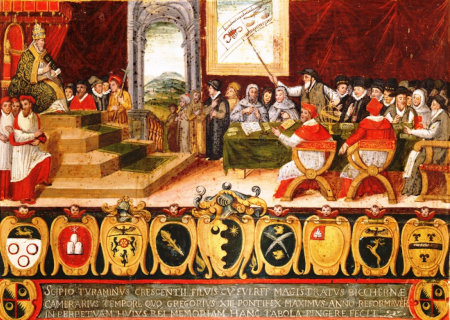
Written under his formal Latin name, Aloysius Lilius, the mathematician had based his work on the popular Alfonsine
Tables, ordered by Alfonso the Wise in Spain in 1252. These gave the length of the year as 365 days 5 hours 49 minutes
and 16 seconds. The Julian calendar year was 365 days 6 hours. How could he adjust the Julian system to the more accurate
length of the year? The 10 minute 44 second difference came to 1 day every 134 years or, in whole numbers, 3 days too
many every 400 years. Lilius decided to remove 3 days every four hundred years by inventing the leap-century rule
– he cancelled the leap year in three out of four century years by saying that only a century year divisible by 400
should be a leap year. So 1600 was a leap year but 1700, 1800 and 1900 (although all divisible by 4 as per a normal
leap year) were not leap years.
This correction worked for the calendar, but there were two other problems to be solved in sorting out the
church’s date for deciding Easter Sunday.
1. The solar calendar spring equinox, which was the starting point for working out the Easter date, had
drifted back from 21 March (a fixed date decided at the Council of Nicæa) to around 11 March.
2. The lunar calendar used for calculating the new moon after the spring equinox was based on the ancient Metonic
cycle which said that the lunar and solar calendars coincided after exactly 19 years. Lilius calculations gave a true time
of 19 years 1 hour 27 minutes 28 seconds which agreed with observations of new moon and full moon being around 4 days out
by this time.
The first problem was corrected by removing ten days from the calendar in 1582.
The second was more difficult. Lilius’ 1 hour 27 min 28 sec behind over 19 years made the Metonic cycle a day behind
after 312.7 years. But the Calendar Commission accepted Clavius’ figure of 312.5 years which made it an exact 8 days
behind over 2,500 Gregorian years. So after each of seven periods of 300 calendar years a day had to be dropped and after
the last 400 years, two days.
A revised compotus (time calculation) was worked out to bring the
solar and lunar calendars into line. The mean solar year is 11 days longer than the mean lunar year (12 full cycles of the moon)
and the difference in days was called the epact number. In the first year of the Meton cycle the epact number is 11,
the next year 22, then 33. When the epact number is 30 or more days, an extra 30-day calendar month is inserted in the lunar
year and 30 taken off the epact number. And so on. In 2025 the epact number will be 30 which will be reset to 0 and an extra
lunar month added to this year. The eaxtra leap day at the end of Year 1 means Year 2 starts with epact number 11.
Note: Actually 11 days is an approximation – the more exact figure is 10.8754 days.
The modern name for a calculation is an algorithm and this is used on internet pages like
this one that give you the Easter date for almost any year.

The Papal Bull or letter of instruction to the churches reproduced
in Christophus Clavius’s Opera Mathematicorum.
Pope Gregory signed the
Papal Bull instructing the Church to amend
the calendar based on Lilius’s calculations on 24th February 1582. The decree stated that the Julian
calendar would be superceded by a new calendar and that the day after 4th October 1582 would be the 15th
October to correct the error of 10 days which had built up in the Julian reckoning. Catholic countries followed
instructions but Protestant countries opposed the Church attitude and took many years to see the worth of the
new calendar. In England it took until 1752 to come round to the idea.
The Gregorian calendar, as used for civil purposes, is now an international
standard. It is designed to maintain synchronicity with the tropical year. It has a cycle of 400 years including
97 leap years (146,097 days). Each cycle repeats the months, dates, and weekdays. The average year length is
146,097/400 = 365+97/400 = 365.2425 days, which is 365 days 5 hours 49 minutes and 12 seconds.
Only 26.784 seconds too long against our mean tropical year; that would add up to only one complete day out in
3,226 years, a huge improvement over the Julian calendar.
A last word on the Calendar
Of course everyone knows there is a more accurate calendar than the Gregorian.
This is the Revised Julian devised in 1923 by a Serbian scientist, Milutin Milanković. He took out thirteen
days, to correct the Julian date, made the start date the same as the Gregorian start date, 1 January 1 AD, and
removed 7 of every 9 century leap years. (If the century divided by 900 does not give a remainder of 200 or 600,
it’s not a leap year)
The average RJC year length is 365.2422 days, which is 365 days 5 hours 48 mins 48 secs.
Only 2.784 seconds too long against our mean tropical year; that would add up to only one complete day out in
31,034 years, a huge improvement over the Gregorian calendar.
Unfortunately only some Orthodox churches moved to the RJC, the rest stuck with the JC for religious reasons.
And the rest of the world was now tied to the Gregorian and couldn’t face changing computer programmes and
adjusting historical dates for what was a minor adjustment. The Gregorian and RJC will only be one a day apart by
the year 2,800 CE.
What is the Week Number?
International standard ISO-8601 assigns a number to each week of the year.
A week that lies partly in one year and partly in another is assigned a number in the year in which most of its
days lie. This means that most years have 52 weeks, but years that start on a Thursday and leap years that start
on a Wednesday have 53 weeks.
English Names of Months and Days of the Week
The Old English calendar of the Britons went thus:
1. Æfterra-ġēola mōnaþ [‘After-Yule month’, our January] 2. Sol-mōnaþ [February, ‘Sol month’] 3. Hreþ-mōnaþ [March, ‘Hretha’s month’] 4. Ēostur-mōnaþ [April, ‘Eostre’s month’] 5. Ðrimilce-mōnaþ [May, ‘Three-milkings month’] 6. Ærra-Liþa [June, ‘Ere-Midsummer solstice’] 7. Æftera-Liþa [July, ‘After-Midsummer solstice’] 8. Wēod-mōnaþ [August, ‘Weed month’] 9. Hāliġ-mōnaþ or Hærfest-mōnaþ [September, ‘Holy month’ or ‘Harvest month’] 10. Winter-fylleþ [October, ‘Winter-filleth’] 11. Blōt-mōnaþ [November, ‘Sacrifice month’] 12. Ærra-ġēola mōnaþ [‘Ere-Yule month’, our December]
The Roman Calendar originally set up at the founding of Rome had ten months in the year – Martis (god Mars) 31, Aprilis (goddess Venus formerly Aphrodite) 30, Maius (goddess Maia) 31, Junius (goddess Juno) 30, Quintilis (fifth) 31, Sextilis (sixth) 30, September (seventh) 30, October (eighth) 31, November (ninth) 30 and December (tenth) 30. This was just more than 61 days short of the solar year and two extra months were promptly added at the beginning – Januarius (god Janus) 29 and Februarius (Sacrifice) 28.
In recognition of Julius Caesar’s triumphs, the seventh month, Quintilis, was renamed Julius and not to be outdone Emperor Augustus had the following month, Sextilis, named after himself. Thus when the calendar settled in England the months became January, February, March, April May, June, July, August, September, October, November and December. Unfortunately Augustus decided his month like Julius’ should have 31 days which leaves us with the irregular system we have today remembered by the 15th century English rhyme:
Thirty days hath November
April, June, and September:
Of twenty-eight is but one,
And all the remnant is thirty-one.
Of course Leap year comes and stays,
Every four years got it right,
And twenty-eight is but twenty-nine.
A 20th century version is:
Thirty days has September
April, June, and November:
All the rest have thirty-one,
Excepting February alone
Which has but twenty-eight days clear,
And twenty-nine in each leap year.
From the time of Emperor Constantine, weekdays were named after the seven known
heavenly bodies so the Romans had: lunae die, Martis die, Mercurii die, Jovis die, Veneris die, Saturni die and
Solis die. That is, the sun, the moon and five planets. The Anglo-Saxons had the German names for Norse Gods:
moon day, Tyr’s day, Woden’s day, Thor’s day, Frigg’s day, saturn’s day and sun day.
These gave us the English names we use today; Monday, Tuesday, Wednesday, Thursday, Friday, Saturday and Sunday.
The Christian Church tried to have weekdays numbered to sever the pagan links but generally the ruling was ignored.
However in a number of Christian countries Sunday is named the Lord’s Day as in dimanche, domingo, domenica.
Time and the Prime meridian
While religions and cultures argued over the Calendar, another interesting
question arose as explorers extended the area of the known world. Sailing to land west of Europe, they realised
that their noon was later than it was at home. And as the idea of a spinning globe that rotates once in a day was
accepted, so present time varies around the world by a regular amount. Noon at one point on the equator is midnight
at a place immediately opposite on the circle. 12 hours difference half way round is 24 hours going right round the
earth so a series of 23 lines can be drawn from the north to the south pole crossing the equator at equal distances
apart (lines of longitude) and each point along a line is 1 hour different to the nearest point on the next line.
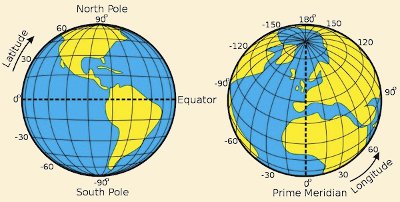
As well as resetting your timepiece as you travelled round the world you
could work out distances on your journey by using a measurement of longitude. The system just needed to be calculated
from a base line, a prime meridian, called the zero meridian. In theory this could be anywhere on earth. Various
international congresses were held to decide on this because the main seafaring nations used Greenwich, Paris,
Lisbon and Cadiz respectively for sea charts and their capital city for land charts so a consensus was needed.
Jewish religious leaders put forward Jerusalem and some geographers suggested Tenerife but it was generally agreed
that the line should pass through a major observatory. A key factor was the widespread use of the British Nautical
Almanac, first published in 1767, based on Greenwich.
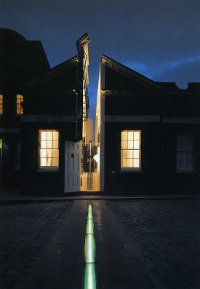
The 1851 George Airey Transit Circle Telescope
on the Meridian Line at Greenwich, London.
In October 1883 the Seventh International Conference decided to go for
Greenwich. It also resolved that a Universal Time should be adopted for travel purposes based on noon at Greenwich
and that longitude should be measured in degrees, a total of 360⁰ around the circle of the equator,
working right round the globe from Greenwich from west to east. These decisions were confirmed at the next
conference in Washington in November 1884 except that midnight was substituted for midday and that longitude
should be measured going 180o in each direction from Greenwich.
In 1998, after the observatory had moved first to Herstmonceaux in Sussex and then later to Cambridge, it was
closed and the original Royal Observatory, Greenwich is now an historic museum.
Daylight Saving Time
Most of the world’s population at high latitudes uses Daylight Saving
Time for the summer half of the year to allow them to enjoy lighter evenings. A New Zealand astronomer, George
Vernon Hudson, came up with the idea when in 1895 he presented a paper to the Wellington Philosophical Society
proposing a two-hour daylight-saving shift. Most of the United States begins Daylight Saving Time on the second
Sunday in March and reverts to standard time on the first Sunday in November. In the European Union, DST begins
on the last Sunday in March and ends the last Sunday in October. In the EU, all time zones change at the same moment.
The old rhyme for the northern hemisphere to remember is “Spring Forward, Fall Back”. In New Zealand,
it begins on last Sunday in September and ends on the first Sunday in April.
The International Date Line
On the opposite side of the globe from the Prime Meridian is the International
Date Line (IDL). Cross this line of longitude and the date changes – one day forward if you travel east to
west, one day back if you travel west to east. Each day starts at midnight on the IDL and, as the earth spins,
midnight moves steadily from east to west. So New Year Day begins in Asia, moves across Africa and Europe and
finally reaches the Americas. The only time the date doesn’t change at the IDL is at the moment of midnight
when the whole earth is at the same day and date just before the next day begins.
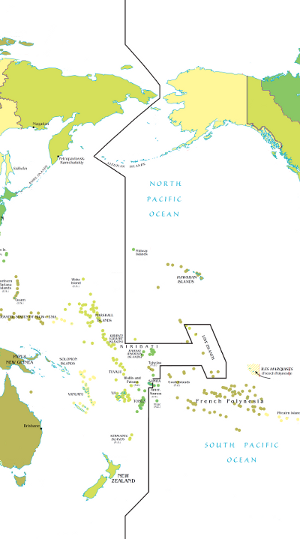
The International Date Line is not a straight line because it crosses several
territories made up of groups of islands. The line is diverted to one side or the other of the whole group. At the
Aleutian Islands, it kinks west and at Kiribati there is a huge kink to the east. The islands of Samoa have recently
moved from east to west of the IDL losing a day in the process and leaving the islands of American Samoa (a US Naval
base) on the other side.
Sorting themselves out
In the United Kingdom. the driving force behind standardising the time
all over the UK was the railways. On a journey from London to Plymouth, each station would show a different time
so that it always appeared that trains took longer than shown on the driver’s pocket watch set to London time.
George Bradshaw’s Railway Timetables tried to work with local time but the proprietor must have been relieved
when the Great Western Railway set all its station clocks to London Greenwich Mean Time in November 1840 and other
companies followed shortly afterwards to create a universal railway time. Horse-drawn Mail Coaches still pounded the
roads with one firm reported as giving it’s coach guards a timepiece regulated “to gain about 15 minutes in
24 hours, so that, when travelling eastwards it might accord with real time. Of course, in the opposite direction a
corresponding allowance was made.” In 1880, it must have been to great general relief that government legislation
brought all public clocks into line with GMT.

The invention of the electric telegraph, which was patented on 12 June 1837 by William Cooke and
Charles Wheatstone, and the invention of a code to transmit information along the wires by Samuel Morse, led to its
establishment as a practical tool with a Central Telegraph Station being set up in London. Morse joined the New York,
Newfoundland and London Telegraph Company in 1854 and the first successful submarine telegraph cable was laid across
the Atlantic from Valentia Island, Ireland to Trinity Bay, Newfoundland on 7 September 1866.
Across the Atlantic, North America is a big continent and noon
on the Pacific Coast is over three hours after noon on the Atlantic coast. When the fastest travel was by
stagecoach the fact that every town and city had its own time didn’t matter. The traveller would adjust
his pocket watch when he reached the next stop on his journey. However the railroad had problems from the
beginning as each company kept its own time. In October 1869 a Convention was held in New York city to discuss
the situation and a college professor was asked to draw up a plan. Professor Dowd proposed four different
standard time zones to cover the country - the boundaries would depend on state boundaries and individual
railroad company areas. He suggested setting up a zero meridian through the observatory in Washington D.C.
However after consulting widely he decided on using the 75th meridian of longitude west of Greenwich as the
first time zone, five hours after Greenwich mean time (now Eastern Standard Time). The other zones were 90
degrees west (Central Time) 105 degrees west (Mountain Time) and 120 degrees west (Pacific Time). At noon on
Sunday 18 November 1883 public clocks all over the US were set to the new standard times using the electric telegraph.
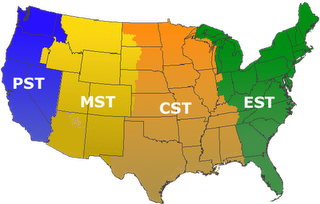
Harper’s Weekly magazine on 29th December 1883 reported it like this:
“On Saturday, the 17th of November, when the sun reached the meridian of the eastern border of Maine,
clocks began their jangle for the hour of twelve, and this was kept up in a drift across the continent for
four hours, like incoherent cowbells in a wild wood. But on Monday, the 19th – supposing all to have
changed to the new system on the 18th – no clock struck for this hour till the sun reached the
seventy-fifth meridian. Then all the clocks on the continent struck together, those in the Eastern Section
striking twelve, those in the Central striking eleven, those in the Mountains striking ten, and those in the
Pacific striking nine. The minute-hands of all were in harmony with each other, and with those of all
travellers’ watches. Time-balls everywhere became perfectly intelligible, and the bliss of ignorance
was no longer at a premium.”
Some countries such as the UK are small enough to have one time throughout,
much larger countries such as the USA as described above and Australia need a series of time zones. Some
large countries such as China do have one time throughout but this can mean a disconcerting difference between
noon by the clock and noon by the sun. A few countries such as India and Venezuela straddle the one-hour zones
and it makes sense for India to be UTC + 5½ hours and Venezuela to be UTC - 4½ hours.
Showing the time
The world’s first public time signal was the Greenwich time
ball set up in 1833.
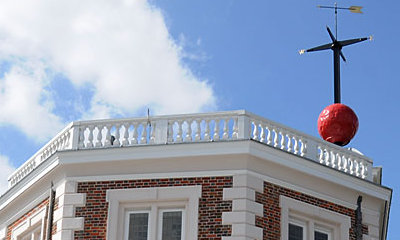
The red ball was raised just before the hour and dropped exactly at 1 p.m.
every day so that ships on the river Thames nearby could set their chronometers by it. It was visible over most
of the city of London as well. At first it was operated by hand but from 1852 it was raised by hand but employed
galvanism (now called electricity) to drop the ball at the exact time.
Displays of World Time are found in trading centres across the world.
|
|
|
|
Courtesy of time and date website.
Broadcasting time
Perhaps the most attractive and recognisable broadcast
time signal is that of the clock named Big Ben in London. The name is actually the name of the largest bell. Big Ben
was first heard over the radio at midnight on 31 December 1923, to announce the New Year. The tune is called the
Cambridge Quarters, First there are the chimes and then, after a pause, the famous strike of twelve for midnight
with the last note marking the hour:
The Greenwich Time Signal (GTS), popularly known as the ‘pips’ was the idea of Frank Dyson, the Astronomer Royal, in 1923. They have been broadcast by the BBC since February 1924 and copied throughout the world. The last pip marks the hour.
The ‘Speaking Clock’ or ‘l’horloge parlante’ telephone time service was first set up by the Paris Observatory in February 1933. The time was recorded by Marcel La Porte.
The horloge parlante service ended on 1st July 2022.
The first UK speaking clock, recorded by Jane Cain, was in service from 24 July 1936 and still operates today on dialling 123 in the UK. This recording is courtesy of Telephones UK
CBC Radio has broadcast a time signal at 12:59 p.m. eastern standard time from 5th November 1939 to the present day.
In the present day, showing and broadcasting the time have come together
with the advent of the radio-controlled clock. It is synchronized by a time code bit stream transmitted by a
radio transmitter connected to a time standard such as an atomic clock. It uses a Long Wave radio frequency for
transmission as it performs most consistently in the stable lower part of the ionosphere. In England the transmitter
is at the Anthorn radio station in Cumbria and covers a radius of 1500 km; in Germany, the transmitter is at Mainflinger,
south-east of Frankfurt and broadcasts Central European Time; in the US, NPL operates radio station MSF, at Fort Collins,
Colorado which broadcasts a high-power, low frequency signal which is able to cover the US itself and most of Canada
and Central America. The user has to set his clock or watch for his time-zone. Lastly, BPM is the People’s
Republic of China’s national time signal service. It is broadcast from Xi’an.
Measuring the hours
One of the earlist attempts to organise the day was the Saxon system of eight
three-hour long ‘tides’ – four for the day and four for the night. They were: from around 4:30am Morgen,
Daeg-mael, Mid-daeg, Ofanverth dagr and from 4:30pm Mid-aften, Ondverth nott, Mid-niht and Ofanverth nott. There are
traces in the English words still in use, noontide and eventide.
Religions in particular needed a unit of time that was smaller that the day for prayer
times, and various devices were invented. The simplest used the sun. A vertical stick cast a shadow which moved across
and when it was at its shortest the time was noon. Using a marked dial made of stone or metal the time between dawn and
noon and noon and sunset could be divided up into useful lengths of time. The Babylonians may have been the first to
suggest 12-hours each for night and day, reflecting the 12 months of the year. Sundials began to appear everywhere.

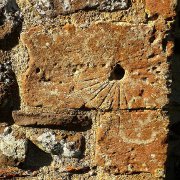
and St.Ethelburga Church in Lyminge, Kent, has a sundial carved on the wall.
The problem with any sun clock is that the hours in the day are longer in summer and shorter in winter as you move
away from the equator. Long hours and short hours were not satisfactory.
The water clock was more successful as it worked by measuring the time it took for the level in a container to drop
a certain distance. Ktesibios of Alexandria invented one around 240 BCE.
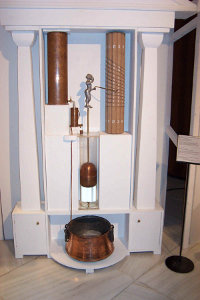
This is a modern reconstruction of Ktesibios' water clock
which was demonstrated at the Second International Conference on
Ancient Greek Technology held in Athens in 2005.
For about 600 years hourglasses were a simple time measure as well as candles with
hour markings. The candle gave a rough idea, the hourglass was more precise.

By the 14th century, large mechanical clocks driven by weights had appeared
in towers of several large Italian cities. Around 1510 Peter Henlein, a German locksmith from Nuremberg invented
spring-powered clocks. These slowed down dramatically as the spring wound down and they didn’t have a
minute hand, only an hour hand. In 1656, Christian Huygens, a Dutch scientist, made the first pendulum clock
with an accuracy of less than one minute per day and eventually achieved errors of less than 10 seconds a day.
The minute hand was added around this time.
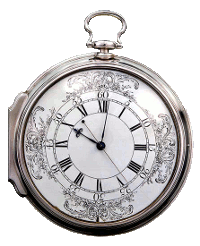
Harrison’s No. 4 Timekeeper
It was designed by John Harrison and made by watchmaker
John Jefferys. It is 13 cm in diameter and weighs 1.45 kg.
The pressure to improve mechanical timekeeping came from sailors who required
a reliable timepiece to take on journeys for the calculation of longitude. In stormy seas any pendulum device failed
completely. The great name in this regard was a Yorkshire clockmaker John Harrison. His story is told in Dava
Sobel’s book, ‘Longitude’. He was awarded a prize of £18,750 for over 40 years work leading
to the production of his No.4 timekeeper submitted to the Board of Longitude in London in 1761. A less-expensive
duplicate for £450 made by clockmaker Larcum Kendall in 1770 went with Captain Cook on his second and third
voyages and became “our never failing guide”.
Today, time intervals based on astronomical observations Co-ordinated
Universal Time or UTC are compared to time based on the vibration of atoms known as International Atomic Time
or TAI. Whereas UTC seconds vary continuously by tiny amounts based on planetary movements the TAI second,
checked against atomic clocks all over the world, is absolutely uniform. This actually means that a leap second
has to be added at intervals so that the clock keeps in step with actual earth time which is needed particularly
by navigators and astronomers. The world’s time signals were co-ordinated from the Bureau International de
l’Heure at the Paris Observatory but from 1987 are handled by the International Bureau of Weights and
Measures (BIPM) at Sèvres, France and the International Earth Rotation and Reference Systems Service (IERS).
The SI second was defined in 1967 as “the duration of 9,192,631,770 periods of radiation corresponding
to the transition between two hyperfine levesl of the ground state of the caesium-133 atom” at 0degK and mean sea
level atmospheric pressure. Atomic clocks at differing altitudes show times which differ by nanoseconds due to
gravitational time dilation - in other words the higher the altitude the faster the caesium ‘ticks.’
The standard caesium atomic clock keeps time to within 1 second in about 100 million years!
The latest development (2010) at the U.S. National Institute of Standards and Technology is the
‘quantum logic’ clock which uses a single aluminium ion vibrating at ultraviolet light frequencies.
This clock has an estimated accuracy of 1 second in about 3.7 billion years. However the present atomic clock
standard is considered accurate enough for current usage.
Since the latest atomic clocks are more accurate than the earth’s
progress in the solar system it has found to be necessary to constantly adjust the atomic clock to keep the two
in line so as to avoid midday drifting away from noon. This at present involves adding a leap second at irregular
intervals. From 1st January 1972 (when UTC was set exactly ten seconds slow on TAI) to date (1st Jan 2022),
twenty-seven leap seconds have been added. This system has proved workable so far.
Astronomical Time
In 1862 the British Association for the Advancement of Science stated that
“All men of science are agreed to use the second of mean solar time as the unit of time” This meant
the second was defined as 1/86,400 of the solar day.
Astronomy now uses a standard Julian Day (not related to the Julian Calendar)
which was invented by Joseph Scalinger in 1853. He combined three cycles, the 28-year solar cycle, the 19-year
Metonic or moon cycle and the period bewtween taxation years in ancient Rome called the 15-year induction period.
28 x 19 x 15 gave him his Julian Period of 7,890 years and he set the first day of year 1 as 1 January 4713 B.C.E.
when all three cycles were at the same start point. This little calculator
gives you the Julian Day Number for any
date. His Julian Days begin at solar noon UTC. Each year has 365 days and at noon on 1/1/2000 the day with JDN
2,451,545 started.
Actually the noon start became irrelevant and the large JDN cumbersome so a Modified Julian Day Number is
now used which equals JDN-2,400,000.5 so noon on 1/1/2000 the MJDN is 51,544.5
Interesting Facts
By 1695 astronomer’s had concluded that the moon’s speed across
the sky is increasing and by the end of the nineteenth century it was demonstrated that the earth’s speed
of rotation is slowing down by around 1.5 milliseconds per century. Various factors are thought to be involved
including the drag of the tidal waters in shallow seas and friction between the earth’s molten core and the
thin layer of rock floating above on which we live.
The earth doesn’t spin evenly but has a slight wobble as the axis
moves in a very small circle over time (called a precession). This means that both longitude and latitude are always slightly changing
which means local astronomical time too is always slightly changing over the surface of the globe.
The earth speed in orbit varies as it passes close to and farther away
from the sun causing the sun to appear to travel slightly faster across the sky in the northern spring and
slower in the autumn.
The Sun moves slightly more than 1 degree eastward each day with respect to the
stars and takes 365.242190 days to come back to the same position against the stars. The Moon moves about 13 degrees
eastward each day with respect to the stars and takes 27.3217 days to come back to the same position against the stars.
If you draw a flat surface through the centre of the sun and the earth’s
orbit (the ecliptic plane), this is tilted at 23.5 degrees with respect to the celestial equator. This presents an
ever-changing side of the earth to the sun and gives us our earth seasons.
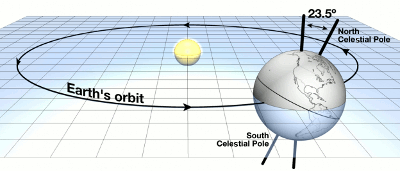
At the two annual equinoxes (in spring and autumn), the hours of daytime
(when the Sun is above the horizon) and nighttime are 12 hours each for all latitudes on Earth.
TThe rotation of the earth around the sun, the moon around the earth and spin of
the earth itself are all counterclockwise as seen from above the earth’s north pole.
Finally did you know that the path of the earth round the sun is gradually shifting?
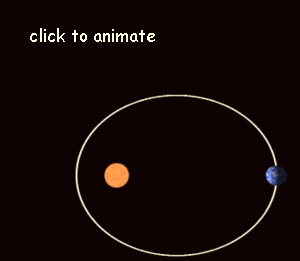
Sources:
Poor Richard’s Almanack, 1733David Ewing Duncan The Calendar Fourth Estate 1998
Jacqueline de Bourgoing The Calendar – Measuring Time Thames & Hudson 2001
Derek Howse Greenwich time, and the discovery of longitude OUP 1980
Old English Calendar http://en.wikipedia.org/wiki/Month Accessed 22/12/2011
The Metonic Cycle http://www.sizes.com/time/lunar_cycles.htm Accessed 22/12/2011
Calendar Converter http://www.fourmilab.ch/documents/calendar/ Accessed 7/1/2012
H.Joyce The History of the Post Office 1893. Mail coach time, page 283
G.R.M.Garratt One Hundred Years of Submarine Cables Science Museum, London 1950
Cmdr. Rupert T. Gould John Harrison and his Timekeepers National Maritime Museum 1958